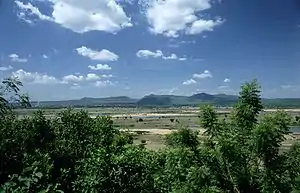Mandara Mountains
The Mandara Mountains are a volcanic range extending about 190 km (about 120 mi) along the northern part of the Cameroon–Nigeria border, from the Benue River in the south (9.3°N 12.8°E) to the north-west of Maroua in the north (11.0°N 13.9°E).[1] The highest elevation is the summit of Mount Oupay, at 1,494 m (4,900 ft) above sea level (10°53′N 13°47′E).[1]


The region is densely populated, mainly by speakers of Chadic languages, including both the Mofu and the Kirdi ethnic groups.[1][2]
Extensive archaeological research has been undertaken in the Mandara Mountains, including work at Diy-Gid-Biy (DGB) sites.[3]
Geology
The Mandara Mountains were formed millions of years ago when a continental plate of basement rock deep beneath the African continent rose up, fragmenting and splitting as it was pushed to the surface. The climate was significantly wetter in those times, so enormous amounts of precipitation formed numerous rivers that rushed through these fractures, carving them deeper and wider, resulting in the range's notably rugged terrain.[1]
Volcanic activity also played a role in the formation of the range. Eruptions of lava formed volcanic cones whose vents were eventually plugged with hardening magma. These hardened cores are called volcanic plugs. In the case of the Mandara Mountains, the plugs were much more erosion-resistant than the exterior of the cones, which wore away over time. Eventually, only the plugs remained, forming the stark, needle-like spires such as Kapsiki Peak that the range is known for.[1]
Gallery
 Cross sectional view
Cross sectional view View of small Mountains
View of small Mountains The mountain peak
The mountain peak View of a pointed Rock form
View of a pointed Rock form Sunset view
Sunset view

See also
References
- Scheffel, Richard L.; Wernet, Susan J., eds. (1980). Natural Wonders of the World. United States of America: Reader's Digest Association, Inc. pp. 226–227. ISBN 0-89577-087-3.
- "A Dormant Volcanic Range in Adamawa". Folio Nigeria. Retrieved 17 August 2020.
- "Les Diy-Gid-Biy du Mont Mandara". UNESCO World Heritage List. Retrieved 29 May 2016.